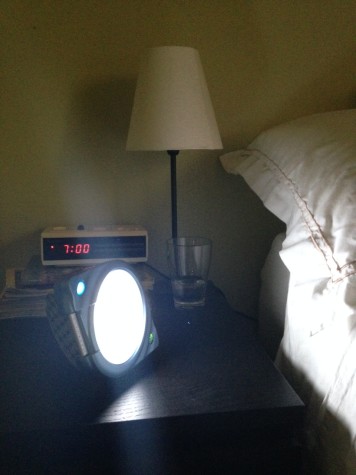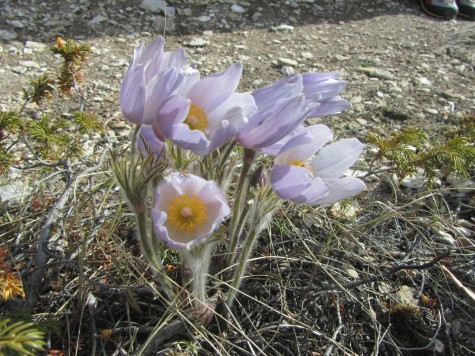
It’s a beautiful spring day here in the Canadian Rockies, and inside my head I’m a slightly less perky Julie Andrews running through the fields singing The hilllls are alive, with the soouund of muusiiiiiic. I’m feeling much more upbeat than I was a couple of months ago. Sixteen hours of daylight stretch gloriously before me each morning, and it makes all the difference.
Let me start by telling you how the short, dark days of winter begin at our house:
When my alarm goes off at 6:50am, I hit two buttons. The first turns off the grating beeping of my yellowing, twenty-year-old alarm clock, and the second turns on my 10,000 Lux, full-spectrum light.

10,000 Lux is a lot of light intensity—imagine snugging your cheek up beside your car’s headlight and then voluntarily cranking it on. As I awaken, I must force open my lids to let the light blast across my eyeballs, because unfortunately, the magical metabolic kick-start doesn’t happen otherwise. Theoretically, one should not feel their pupils contract, and yet I am acutely aware something gritty and uncomfortable is happening in there.
Half an hour later, just as my morning light session comes to an end, my ten-year-old son bursts into our room, on cue. His dawn-simulator has reached full illumination to the sound of factory-programmed birds chirping. His association with these birds’ song is likely one similar to having his skin sandpapered, but the birds do the trick. So begins our day of convincing our bodies that, hooray, it’s morning, even though in the heart of winter it’s still pitch black outside.
How pitch black? In Jasper National Park at almost 53 degrees latitude, on the darkest days, the sun will rise around 8:50am and will set just after 4:00pm. However, up against Whistlers Mountain here on the west side of town, we don’t get direct light until around 10:00am, and the sun will disappear behind the mountain at 2:00pm.
In the winter, if I did not have to deliver a child to school every morning, I would certainly sleep a lot more. I have less energy, and I’m more prone to what psychiatrists call low moods. This neat little package of bothersome symptoms is often called the winter blues—a condition generally attributed to shorter day length. It’s on the mild end of a spectrum called Seasonal Affective Disorder (SAD), a type of clinical depression that abates in the spring and summer.
Depending on who you ask, about 10-20 percent of North Americans are estimated to experience the winter blues every year, and another three to six percent will experience the major depressive symptoms of SAD.
It sure seems like a lot more than that when I poll my group of friends. In fact, many of these friends (n = no real science conducted) use a full-spectrum lamp, or antidepressants, or both, to get through the dark months. Apparently, the lamp and the drugs can have roughly equal effectiveness, depending on how they’re used. I’ve tried both, but I think I’ve found the most success with my lamp.
Why does it work? Dr. Raymond Lam, Head of the University of British Columbia Mood Disorders Centre, says there are a couple of main hypotheses. One rests on the idea that SAD is a disturbance in the biological clock of the brain. “We know that the biological clock is reset daily by bright light, and people with SAD may not be able to shift their clock with the changing levels of light from summer to winter” says Lam. “These people seem to need a brighter light than normal to reset their clock.”
The other major idea, says Lam, is that SAD is a disturbance in the same neurotransmitters, like serotonin and/or dopamine, affected in other types of depression, and that the bright light affects those neurotransmitters in the same way antidepressants do. A new study claims to have identified a mechanism underpinning this theory, at least in mice.
There is some evidence for and against both of those leading hypotheses, Lam says, but “The jury is out in terms of the actual reason light therapy works.”
The main point is that for many people, it does. In some countries, these bright lights are a part of everyday, public life. Full-spectrum lights are used in schools, hospitals and office buildings throughout Scandinavia. There is a café in Stockholm that allows you to shift your biological clock while getting juiced on espresso. Hell, Rjukan, a town in Norway, even built giant mirrors to beam real sunlight into town to break up what would normally be six months without direct sunlight. The mirrors only illuminate a small square (600m2) in the middle of town, but it’s enough that the locals can go get a daily hit. Imagine the conversation: “Bright enough for you today Erik?’
If I’m ever in doubt that my daily blast of bright light is key to a sane winter, I only need to not use it for a few days. Shortly thereafter I’m begging my husband to call in favours from his wildlife vet colleagues at the San Diego Zoo, and relocate us to California. Last year he asked me to make him a deal that we wouldn’t make any big life decisions between November and February. I agreed, with the condition that purchasing shoes isn’t considered a big decision.

Now that spring is here, I can pack away my lamp, along with the dark days of winter. Today, the sun rose at 5:35am, and won’t set until 9:27pm. It is no longer about simulating dawn for my son, but darkening his room enough that he can sleep–a much preferable problem. In the coming months, with rediscovered energy I’ll rise with the magpies and garden late into the evening. The sun will beat more light into my body than you can shake a full-spectrum lamp at, and I’ll feel just fine.
*******
Photos:
1. Happy spring lady jumping credit: Creative Commons BeYounger.com.
2. Bright light credit: Niki Wilson.
3. Crocuses credit: Niki Wilson.
Great article Niki. On top of all of this, you choose to write, which can at times make the darkness even more foreboding. So we choose to surround ourselves with “bright lights” including those people who pull us through the dark times and aptly point out that only in the dark can you really see the stars (or the headlights coming toward you)! Keep your great sense of humour, enrich us with your great writing, and keep the lights blazing!
Thanks, George! I love your analogy–bright lights really can come in all forms.
Lordy, I hate spring – hay fever continuously from September to December (that’s when spring is in my neck of the woods). Last year I avoided it by visiting San Francisco and Portland, Oregon, for that time. It’s a bit expensive to do every year, alas.
If it’s not one thing it’s another, hey Peter? I hope you find some affordable relief, although Portland sounds like a fantastic option when you can take it. Here’s to summer, and easy breathing!